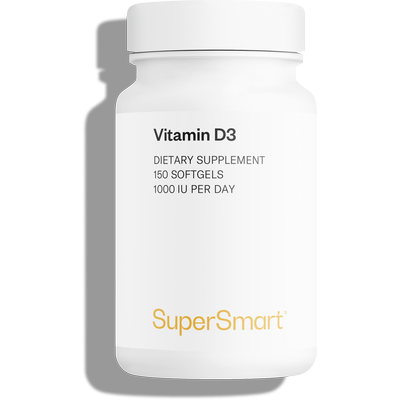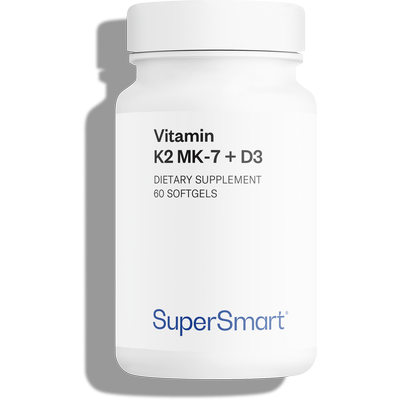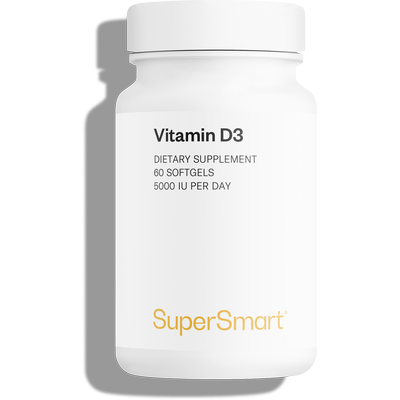12-10-2016
Vitamin D3: scientists call for upper safe limit to be raised to 10,000 IU
 Over the last fifteen years, a number of clinical studies have shown that taking appropriate doses of vitamin D may offer even greater benefits than previously thought, extending far beyond its recognised role in bone health. A body of evidence gathered from epidemiological studies and clinical trials indicates that increased vitamin D status may reduce the risk of various cancers. Additional data suggests it may help to both maintain physical strength in older individuals, reducing their risk of a fall, and lower the incidence of metabolic syndromes. .
Over the last fifteen years, a number of clinical studies have shown that taking appropriate doses of vitamin D may offer even greater benefits than previously thought, extending far beyond its recognised role in bone health. A body of evidence gathered from epidemiological studies and clinical trials indicates that increased vitamin D status may reduce the risk of various cancers. Additional data suggests it may help to both maintain physical strength in older individuals, reducing their risk of a fall, and lower the incidence of metabolic syndromes. . Vitamin D is a fat-soluble vitamin which can be obtained from the diet but which is also produced by the body on exposure to sunlight. The sun’s rays trigger vitamin D production in the innermost layers of the skin from dehydrocholesterol, cholesterol’s immediate precursor.
Vitamin D exists in several forms which are distinguished by a numerical index. The most active of these in the body are the D2 (ergocalciferol) and D3 (cholecalciferol) vitamins. There are also numerous derivatives including three steroids that play a particularly important role: 25(OH)D or calcidiol, 1,25(OH)2D or calcitriol and 24.25(OH)2D
Dietary vitamin D is absorbed with fats in the small intestine before it passes into the bloodstream. That produced when the skin is exposed to sunlight passes directly into the blood. In the liver, vitamins D2 and D3 are converted into 25-hydroxy-vitamin D, the major circulating form of vitamin D. The conversion into its active form, 1,25-dihydroxy-vitamin D, occurs in the kidneys.
Vitamin D is found in nutritional supplements in both D2 and D3 forms, but because the D2 form degrades more rapidly in the body, it appears to have only 20-40% of D3’s efficacy at maintaining serum concentrations of 25-hydroxy-vitamin D.
Vitamin D3 and bone health
Among vitamin D3’s best-known and established benefits is its ability to improve the health of the musculoskeletal system. One of its main biological roles is to maintain normal blood levels of calcium and phosphorus. By promoting calcium absorption, vitamin D helps form and maintain strong bones. It also works in conjunction with certain other vitamins and minerals, as well as hormones, to promote bone mineralisation.Vitamin D deficiency causes osteopenia, precipitates and exacerbates osteoporosis, is responsible for a painful bone disease called osteomalacia, and increases muscle weakness and thus the risk of falls and fractures. It can alter the mechanism that regulates the parathyroid hormone and cause secondary hyperparathyroidism, increasing the risk of osteoporosis and fracture1. In a journal article concerning women with osteoporosis hospitalised due to a hip fracture, 50% had signs of vitamin D deficiency2.
Protection against cancer
It was in the 1940s that a scientist first observed a link between vitamin D3 and cancer prevention. He noted that individuals living in sunnier climates had lower mortality rates from cancer and suggested that exposure to the sun may provide some degree of immunity against cancer. Over the past 60 years, researchers have indeed observed an inverse association between sun exposure and cancer deaths. A significant number of studies have suggested that deficiency in vitamin D3 is associated with an increased risk of various cancers including that of the breast, ovary, prostate and colon3.Reduces the risk of colon and breast cancer
The relationship between low blood levels of vitamin D and increased cancer risk is most evident in the case of colorectal cancer. Vitamin D’s protective effect was revealed in a study of 3000 adults (96% male) who had undergone colonoscopies between 1994 and 1997 to look for lesions or polyps in the colon. Advanced neoplastic lesions were found in 10% of participants. The risk of advanced cancerous lesion was found to be much lower in subjects who consumed more vitamin D4.
Researchers surgically divided adenomatous polyps in 19 patients, removing approximately 50% and marking the remaining polyps in the intestine for later identification. They then studied cell proliferation in the polyp tissue before and after six months’ treatment with 400 IU of vitamin D3 and calcium carbonate (1500mg three times a day) or placebo. Cell proliferation and other signs of cancerous changes were clearly lower in treated patients while no change was observed in the placebo group.
In another study, scientists studied 1179 healthy menopausal women (aged over 55 with no known incidence of cancer in at least the 10 years preceding the study). They were randomly assigned to be given either 1400-1500mg of calcium alone, 1400-1500mg of calcium plus 1100 IU vitamin D3 or placebo. Over the study’s four year duration, the women in the calcium/vitamin D3 group saw their risk of cancer fall by 60% in comparison with women in the other groups. As it was possible that some women may have had an undiagnosed cancer at the start of the study, the researchers discounted the first year’s results and analysed only those of the last three years of the trial. This revealed even more significant results with a 77% reduction in cancer risk in the supplemented group5.
2000 IU of vitamin D a day
According to two meta-analyses examining data from a number of studies, vitamin D could help prevent half of all breast cancer cases and two-thirds of colon cancer cases in the US. The first meta-analysis on breast cancer indicated that women with the highest blood levels of 25-hydroxy-vitamin D, or 25(OH)D, had the lowest risk of breast cancer. Researchers divided participants’ records from two studies into five quintiles, ranging from the lowest 25(OH)D concentration (less than 13 nanograms per millilitre - 13ng/ml) to the highest (approximately 52ng/ml). Data also included whether or not the subject had developed cancer. Co-author of the analysis, Cedric Garland, stated that “The data was very clear demonstrating that individuals in the group with the lowest vitamin D blood concentrations had the highest incidence of breast cancer and that incidence fell when 25(OH)D blood levels were higher. Serum concentrations associated with a 50% risk could be maintained by taking 2000 IU of vitamin D3 a day, combined where possible with 10-15 minutes of sun exposure6. »
The meta-analysis on colorectal cancer analysed five studies examining the association between blood levels of 25(OH)D and risk of colon cancer. In all five studies, blood samples were taken from healthy volunteers to measure 25(OH)D concentrations. Subjects were then followed up over 25 years to see whether or not they went on to develop colorectal cancer. In a similar way to the above-mentioned meta-analysis, data on a total of 1448 individuals was ordered according to serum 25(OH)D concentration and then divided into quintiles, ranging from the lowest to the highest concentration.
According to study co-author Edward D. Gorham, “This meta-analysis shows that elevating serum 25(OH)D concentrations to 34ng/ml could halve the incidence of colorectal cancer. We would expect to see a two-thirds reduction in incidence with serum concentrations of 46ng/ml, which corresponds to 2000 IU of supplemental vitamin D3 a day. The best way of achieving such concentrations is through a combination of dietary sources, nutritional supplements and 10-15 minutes a day of sun exposure”7.
These two meta-analyses were conducted by cancer prevention specialist Cedric F. Garland and colleagues at the University of California Moores Cancer Center in San Diego. They subsequently examined data from various studies conducted in 15 different countries between 1966 and 2004 on winter serum vitamin D levels. The amount of sunshine and cloud cover was measured by satellite in these countries. They then applied this data to 177 countries in order to evaluate their populations’ average blood concentrations of vitamin D metabolite. They estimate that 250,000 cases of colon cancer and 350,000 of breast cancer could be prevented each year across the world by increasing consumption of vitamin D3, particularly in northern hemisphere countries. 8. The two previous studies showed a protective effect starting at serum 25(OH)D concentrations of 24-32ng/ml9.
Protection for the prostate
Recent clinical trials suggest that vitamin D and its analogues may constitute important treatments for prostate cancer. Experimental data indicate that the active form of vitamin D promotes cell differentiation while inhibiting proliferation, invasion and metastasis of prostate cancer cells. In examining existing links between sun exposure and prostate cancer, scientists compared 450 men with advanced prostate cancer with a similar number of cancer-free subjects. They found that those with the highest levels of exposure to the sun had a 50% lower risk of prostate cancer than those with low levels. They believe that such exposure protects against prostate cancer by promoting vitamin D synthesis. However, given the known association between sun exposure and certain skin cancers, they think it preferable to increase vitamin D intake through nutritional supplements and the diet10.
A further study demonstrates a therapeutic role for vitamin D in prostate cancer. Sixteen men previously treated for the disease were supplemented with 2000 IU of vitamin D and their levels of prostate specific antigen (PSA - a marker of prostate cancer recurrence or progression) were monitored for two years. In nine patients, PSA levels fell or were unchanged after vitamin D supplementation began. In those in whom levels continued to rise, the supplementation significantly lengthened the PSA doubling time - by 75%. (The rate at which PSA increases or doubles is correlated with the disease’s prognosis: the longer the time it takes to double, the better the prognosis). These results suggest that vitamin D could help prevent or slow disease recurrence or progress in patients previously treated for prostate cancer11.
Deficiency impairs immunity
Vitamin D3 deficiency has been linked to various aspects of immune health. Vitamin D3 regulates T lymphocytes which are important for strong and healthy immune function. It acts as an immune system modulator, preventing over-expression of inflammatory cytokines and increasing the destructive efficacy of macrophages. In addition, it powerfully stimulates the expression of potent antimicrobial peptides present in the cells of the immune system such as neutrophils, monocytes, natural killer cells and cells that line the respiratory system. These vitamin D3-stimulated peptides play a major role in protecting the lungs from infection. Furthermore, vitamin D3 deficiency influences the onset and progress of various auto-immune diseases.A recent scientific article presented convincing evidence that seasonal infections such as influenza could actually be the result of a decrease in vitamin D concentrations over the winter months rather than an increase in viral activity as has long been believed to be the case12. Vitamin D receptors are present on many of the immune system cells responsible for destroying viruses and bacteria. Vitamin D, which is in short supply from the environment during the winter, appears to be essential for the correct activation of these cells.
Beneficial in cases of heart failure
Heart failure - when the heart cannot pump enough blood to meet the body’s needs - is a major cause of death in industrialised countries. Scientists believe that raised levels of circulating pro-inflammatory cytokines may contribute to heart failure and that vitamin D could provide protection by stifling these inflammatory mediators.In a double-blind trial, 123 patients with congestive heart failure were randomly assigned to receive either 2000 IU vitamin D plus 500 mg of calcium/day or a placebo plus 500 mg of calcium/day for nine months. In the vitamin D-supplemented patients, researchers observed a significant increase in levels of the anti-inflammatory cytokine interleukin 10 and a decrease in those of the pro-inflammatory cytokine tumour necrosis factor. They believe that in reducing the inflammatory environment of patients with congestive heart failure, vitamin D constitutes a promising therapy13.
May help prevent diabetes
Vitamin D may reduce predisposition to type 2 diabetes by slowing down the loss of insulin sensitivity in subjects exhibiting warning signs of the disease. Researchers examined 314 non-diabetic adults who had been given 700 IU of vitamin D and 500mg of calcium a day for three years. In those who had shown slightly raised fasting blood glucose levels at the start of the study, supplementation slowed down the rate of increase and stopped the rise in insulin resistance, as compared with controls. The researchers concluded that for older people with abnormal blood sugar levels, supplementation could help prevent metabolic syndrome and diabetes14.Preventing falls among the elderly
Falls are a frequent occurrence among the elderly and are significantly associated with morbidity and mortality. Research suggests that vitamin D may help prevent them. Cross-over studies have demonstrated that elderly people with higher levels of vitamin D experience fewer falls. A meta-analysis reported that vitamin D supplementation helped reduce the risk of a fall by 22%15. A controlled, randomised study showed that for elderly individuals in long-stay institutions, daily supplementation with 1200 mg of calcium and 800 IU of vitamin D3 for three months cut the risk of a fall by 49%16.Safety of Vitamin D
Vitamin D is generally well-tolerated by adults at daily doses of up to 2000 IU. Several studies have even suggested that up to 10,000 IU a day could be taken without risk or side effects17, although health authorities have set the safe dose at just 1000 IU/day. This is the conclusion of a team of researchers who examined 21 well-designed human studies and clinical trials that used doses significantly above those recommended by the authorities. While the French health authority, Agence française de sécurité sanitaire (Afssa), believes that 200 IU of vitamin D a day is sufficient for an adult to maintain good health (400-600 IU/day for the elderly), scientists are convinced that we need closer to 1000 IU a day.-------------------------------------------------------------------------------
References :
1. Pérez-Lopez F.R., Vitamin D and its implications for musculoskeletal health in women: an update, Maturitas, 2007 June 28, e-pub ahead of print.
2. Le Boff M.S. et al., Occult vitamin D deficiency in postmenopausal US women with acute hip fracture, J. Am. Med. Assoc., 1999, 251: 1505-11.
3. Grant W.B., An estimate of premature cancer mortality in the US due to inadequate dose of solar ultraviolet-B radiation, Cancer, 2002 Mar 15, 94(6):1867-75.
4. Lieberman D.A. et al., Risk factors for advanced colonic neoplasia and hyperplastic polyps in asymptomatic individuals, J. Am. Med. Assoc., 2003, 290: 2959-67.
5. Lappe J. et al., Vitamin D and calcium supplementation reduces cancer risk: results of a randomized trial, Am. J. Clin. Nutr., 2007 June 8, 85(6): 1586-1591.
6. Cedric F. Garland et al., Vitamin D and prevention of breast cancer: Pooled analysis, The Journal of Steroid Biochemistry and Molecular Biology, March 2007, vol. 103, issues 3-5: 708-711.
7. Gorham E.D. et al., Optimal vitamin D status for colorectal cancer prevention: a quantitative meta analysis, Am. J. Prev. Med., 2007 Mar, 32(3): 210-6.
8. Holt P.R. et al., Calcium plus vitamin D alters preneoplastic features of colorectal adenomas and rectal mucosa, 2006 Jan 15, 106(2): 287-96.
9. Garland C.F. et al., Nutrition Reviews, August 2007.
10. John E.M. et al., Sun exposure, vitamin D receptor gene polymorphisms and risk of advanced prostate cancer, Cancer Res., 2005 June 15, 65(12): 5470-9.
11. Woo T.C. et al., Pilot study: potential role of vitamin D (cholecalciferol) in patients with PS relapse after definitive therapy, Nutr. Cancer., 2005, 51(1):32-6.
12. Cannell J.J. et al., Epidemic influenza and vitamin D, Epidemiol. Infect., 2006 Dec, 134(6): 1129-40.
13. Schleithoff S.S. et al., Vitamin D supplementation improves cytokine profiles in patients with congestive heart failure : a double-blind, randomized, placebo-controlled trial, Am. J. Clin. Nutr., 2006 April, 83(4): 754-9.
14. Pittas A.G. et al., The effect of calcium and vitamin D supplementation on blood glucose and markers of inflammation in non-diabetic adults, Diabetes Care, 2007 Feb 2.
15. Bischoff H.A. et al., Effects of vitamin D on falls: a meta-analysis, JAMA, 2004 Apr 28, 291(16): 1999-2006.
16. Bischoff H.A. et al., Effects of vitamin D and calcium supplementation on falls: a randomized controlled trial, J. Bone Min. Res., 2003 Feb, 18(2): 343-51.
17. Hathckock J.N. et al., Risk assessment for Vitamin D, Am. J. Clin. Nutr., 2007 Jan, 85(1): 6-18.
Order the nutrients mentioned in this article

Healthy individuals now require a minimum dose of 1000 IU a day.
www.supersmart.com
Now in a single daily dose! A form of vitamin K2 with high bioavailability
www.supersmart.comFurther reading
10-04-2019
Would you put your faith in a man who was twice awarded the Nobel Prize in two different categories? One of only two people (the...
Read more28-06-2017
As the control centre of the central nervous system, the brain has to deal with a constant flow of data, processing millions of bytes of...
Read more30-04-2018
A newly-published study in The Journal of the American Osteopathic Association shows that the body may be unable to make proper use of vitamin D...
Read more© 1997-2025 Fondation pour le Libre Choix
All rights reserved
All rights reserved
Free
Thank you for visiting our site. Before you go
REGISTER WITHClub SuperSmart
And take advantage
of exclusive benefits:
of exclusive benefits:
- Free: our weekly science-based newsletter "Nutranews"
- Special offers for club members only


















